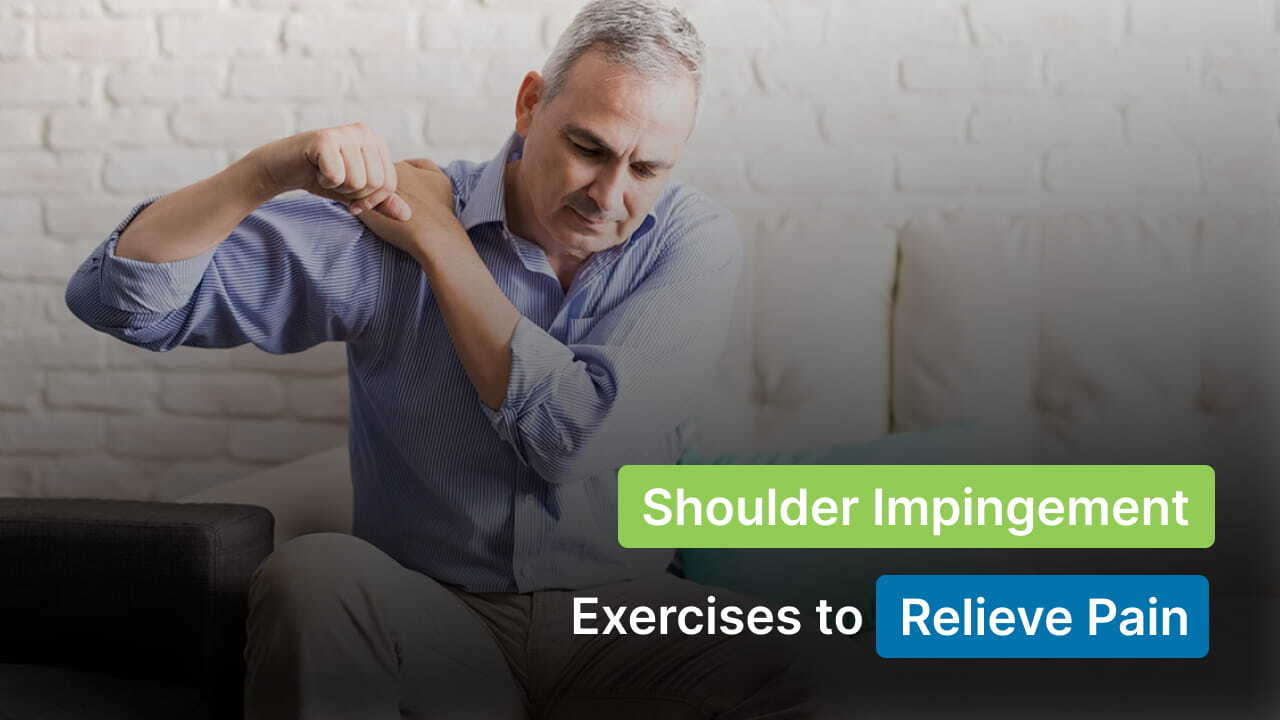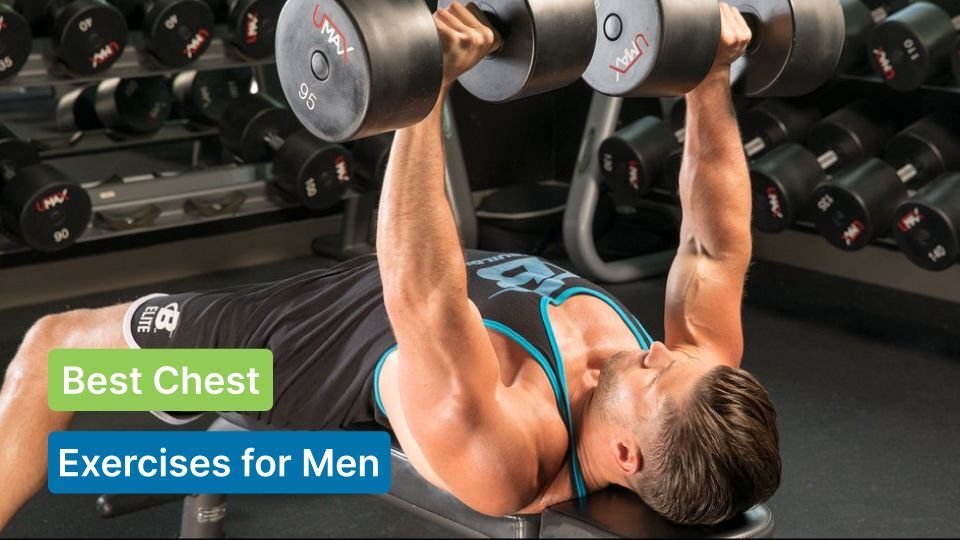
Shoulder impingement syndrome is a common injury seen in athletes, swimmers, and people who perform overloaded arm movements. It is a common cause of shoulder pain that reduces the space between your humerus (top of the arm) and the acromion (top of the shoulder), resulting in loss of range of motion and function.
Overloaded arm movements lead to irritation of the rotator cuff, making the shoulder structure inflamed, swelling, irritated, and further narrowing the space, causing the pain symptoms of anatomical characteristics affecting your daily activities like combing your hair, washing your hair, and throwing a ball.
Well, if you are also experiencing shoulder impingement, this article will inform you about what shoulder impingement is, its causes, symptoms, treatments, with some shoulder impingement exercises to help you relieve the pain.
What is Shoulder Impingement?
According to Nicholas Hershfield, PT, DPT, an orthopedic clinical specialist, shoulder pain is the common cause of shoulder impingement. It usually happens with athletes and swimmers who perform overloaded arm movements, irritating their rotator cuff.
Shoulder impingement is the first phase of rotator cuff pathology. The rotator cuff, also called an acromion, sits on top of the shoulder, which helps lift and rotate your arms. It is a group of muscles and tendons attached to your upper arm bone to your shoulder. In case of shoulder impingement, the rotator cuff rubs the acromion when you lift your arms, and the space between the rotator cuff and acromion narrows, increasing pressure, irritating the cuff, and causing impingement.
In general, impingements occur by repeatedly raising your arms, making the narrow space between the upper arm bone and the top outer edge of the shoulder blade broad, irritating the rotator cuff in between. This can also lead to swelling and improper alignment of the bones and tissues, causing pain. However, strengthening and increasing the mobility of the shoulder joint is a vital step to recovery from shoulder impingement and prevent reoccurrence.
Subacromial pain can occur in:
- Rotator cuff- The group of the muscles and tendons surrounding the shoulder joint.
- Biceps tendon- The muscle that connects the biceps muscle to the shoulder bone.
- Labrum- Tissues or cartilage around the shoulder socket.
- Bursa- These are small fluid-filled sacs in the shoulder joint).
Now, let's look forward to shoulder impingement syndrome causes and symptoms.
Shoulder Impingement: Causes
The leading causes of impingement are the overuse of the shoulder, which makes the tendons swell, constant pain, and weakness in your arm and shoulder. Other causes of impingement are:
- Playing tennis, swimming, baseball, and football involves overhead rotational movements of arms and shoulders.
- Shoulder movements are linked with muscle tightness, imbalances, and weakness in moving the shoulder.
- Dealing with other shoulder joint Injuries.
- Increasing age.
- Bone spurs (small fluid-filled sacs between your tendon and acromion) may develop from wear and tear on bones, causing discomfort and inflammation.
However, these are common causes, which does not mean that doing these activities will lead to shoulder impingement. It can happen to anyone. But thankfully, there are a lot of treatments you can do to prevent it.
Shoulder Impingement: Symptoms
The major symptoms of shoulder impingement include sudden pain and tenderness in your shoulder when you lift your arms. One can also experience pressure, inflammation, and swelling:
- Constant pain in your arm.
- Arm pain that goes from the arm to the front of your shoulder.
- Shoulder or arm weakness.
- Unable to sleep because of pain on the affected side.
- Pain and tenderness in the front of your shoulder.
- Shoulder and arm weakness and stiffness.
Other common sources of shoulder impingement syndrome include bursitis and rotator cuff tendonitis. Shoulder pain can also be caused by severe injury related to the rotator cuff.
11 Shoulder Impingement Exercises
The below mentioned exercises for shoulder impingement are used as part of an entire rehabilitation program to aim to reduce pain and restore shoulder mobility and strength, which relieve your symptoms:
Exercise 1: External rotation with a dumbbell.
- Hold the 0.5 kg of each dumbbell in each hand and bend your arms at a 90-degree angle.
- Pinch your shoulder blades together, and make your forearms parallel to the floor while keeping your arms bent at 90 degrees.
- Do 12-20 reps 3-5 times per day.
Exercise 2: Front-to-side shoulder raises
- Stand feet apart and hold dumbbells in each hand.
- Lift your arms straight directly in front of your chest while keeping your torso still.
- When putting your arms down, lift them to your sides until they are parallel to the floor by slightly bending your elbows.
- Bring down your arms back and repeat the same for 12-20 reps.
Exercise 3: Shoulder extension with band
- Twist an exercise band at your chest level, whether around a door or any stable object, by facing your palm backward.
- Pull your arm backward against the resistance of the exercise band.
- Do 12 -20 reps 3-5 times per day.
Exercise 4: Serratus anterior dumbbell punch
- Lie on your back with a dumbbell holding in each hand.
- Uplift the dumbbell. Ensure to make your elbow straight.
- This will help to strengthen your serratus anterior muscle by stabilizing your shoulder blade when you uplift your arm.
- Do 12 -20 reps 3-5 times per day.
Exercise 5: Standing wall stretch
- Stand by feet hip apart about two feet facing a wall, and place your arms at the wall.
- Lower your chest to the floor and push your hip back.
- Hold the position for 5-8 seconds and return to the starting position.
- Do 12 -20 reps 3-5 times per day.
Exercise 6: Loaded Beast
- Get into the high plank position and shoulder directly over the wrists.
- Push your hips back into heels while lifting your knees off the ground a few inches.
- You can stretch more by moving your head away from your hand.
- Do 12-20 reps.
Exercise 7: Thoracic Extension Variation 1
- Lie on your back on the yoga mat with your knees bent.
- Place the foam roll under your shoulder blades.
- Extend thoracic spine over foam roller while doing J-loop with hand behind head.
- Hold this position for 5-10 seconds and repeat 10 times.
Exercise 8: Strengthen rotator cuff muscles
- Stand at the wall with elbows in and pal holding a resistance band.
- Pinching your shoulder blades together to pull the band away by rotating shoulders.
- Ensure to make little space between the elbow and the body.
- Do 10 reps 3 times per day.
Exercise 9: Floor Cobra Raises
- Lie down on the floor with your face down.
- Place your palms on the floor and lift them on the floor.
- Squeeze your shoulder blades and remain in the same position for 1-2 seconds.
- Do 10 reps 3 times per day.
Exercise 10: Scapular Push-Ups
- Raise your shoulders directly over your wrists, then roll them back and hold. This will squeeze your scapula stabilizers together.
- Focus on moving your shoulder blades, not the spine.
- Hold this position for 5-10 seconds.
- Do 12-15 reps 3 times per day.
Exercise 11: Internal rotation lying down
- Lay down on the upper arm side and flex your elbow on the other arm, lying on the ground at 90 degrees.
- Now, rotate your arm towards the opposite side of your chest without arm straightening.
- You can add resistance by lifting light weights.
How To Diagnose Shoulder Impingement?
A physical therapist, sports specialist, or a shoulder specialist is needed to diagnose the type of impingement. Diagnosis can be done with the hands, X-rays, or sometimes MRI is required. Doctors mainly perform two tests:
- HK Test: The specialist checks the patient's shoulder by placing the arm shoulder at 90 degrees with the elbow flexed in the same degree direction and internally rotates the arm. If the patient experiences pain, it is considered positive.
- Neer's Impingement Sign: This test identifies rotator cuff impingement by flexing the shoulder and applying pressure. The test can reproduce symptoms of supraspinatus or biceps brachii problems and is linked to the Hawkins-Kennedy Test and Jobe's Test.
Doctors may suggest medication and supervised exercise to alleviate pain based on severity and the patient's condition.
Self-care From Shoulder Impingement
Overuse of the shoulder is the primary cause of shoulder impingement. However, you can do some shoulder impingement self-care to prevent pain:
- Ice
Ice is used to calm the inflammation in the affected area, which can be used through an ice pack or ice cup massage. OTC NSAIDs can also be beneficial but should be taken under the doctor's supervision.
- Self-massage with a ball.
- Self-massaging with a ball can help alleviate immediate pain. Self-massage areas include biceps muscles, deltoids, and chest muscles. You can use a tennis or lacrosse ball.
- Place a ball at chest level against a wall to perform a self-massage on your back. Press your chest against the ball and apply some pressure.
- Hold the position for 30-60 sec, and breathe.
- Next, do the same for tight spots on your chest and work on them.
How to Treat Shoulder Impingement?
Shoulder Impingement Syndrome can impact your daily life and prevent you from doing many activities. Treating shoulder impingement syndrome aims to reduce pain and restore shoulder function, including rest, ice, over-the-counter medications, steroid injections, and physical therapy. The following treatment options will help you:
- Cold therapy: Apply ice on your shoulder for 20 minutes at least twice daily to reduce swelling and inflammation.
- Physical therapy: A physical therapist can provide the most effective shoulder impingement physical therapy for individuals who offer relief from pain. It may involve muscle-strengthening exercises that enhance your shoulder posture by improving your rotator cuff muscles. Continuing to follow these exercises gives better results.
- Over-the-counter medication: In mild situations, common anti-inflammatory medications such as ibuprofen (Advil, Motrin), aspirin and ibuprofen, naproxen (Aleve), and acetaminophen (Tylenol) can reduce swelling and pain of shoulder impingement.
- Cortisone or steroid injections: For more severe pain, an effective anti-inflammatory medicine, cortisone or steroid, may be used as a direct injection to reduce pain and inflammation, which benefits the rotator cuff.
- Surgery: Severe impingement is caused by surgery to widen the space around your rotator cuff. Your physician may suggest an arthroscopy surgical technique to repair the joint that uses a tiny camera and very thin surgical tools. After surgery, you have to wear an arm sling.
Final Words
Shoulder Impingement syndrome is common in today's lifestyle, which can be very painful and lead to the inability to perform daily activities. So, it is necessary to take proper care by performing prevention methods. Thankfully, there are many exercises that you can do at home with little or no equipment to help relieve pain.
The above-listed stretches for shoulder impingement will strengthen your shoulder muscles and rotator cuff and improve flexibility. Remember not to put much pressure on your shoulder muscles. If your pain does not go away, consult your doctor; they may advise you with anti-inflammation medicines, depending on your symptoms. Also, try to perform these exercises under a certified supervision physiotherapist of joint and shoulder muscles to avoid worsening pain or condition.
FAQs
1. What is the fastest way to heal a shoulder impingement?
Ans: One can include ice, OTC medicines, physical therapy, and steroid injections for quickly treating the shoulder impingement syndrome.
2. What exercises to avoid with shoulder impingement?
Ans: Exercises to avoid shoulder pain:
- Don't throw anything.
- Avoid lifting, pulling, weightlifting, or pushing.
- Avoid swimming.
- Avoid driving.
3. What vitamin is best for shoulder pain?
Ans: Include vitamin E, which helps to reduce inflammation and protect joint tissues. The B vitamins like B1, B6, and B12 also help to reduce nerve pain linked to shoulder injuries.
4. Which tablet is used for shoulder pain?
Ans: Nonsteroidal anti-inflammatory drugs, or NSAIDs like ibuprofen and naproxen, can relieve shoulder pain by reducing inflammation in the shoulder joint.
Also Read


















































